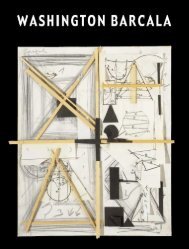dep art amento de conser v ación y - Fundación César Manrique
dep art amento de conser v ación y - Fundación César Manrique
dep art amento de conser v ación y - Fundación César Manrique
You also want an ePaper? Increase the reach of your titles
YUMPU automatically turns print PDFs into web optimized ePapers that Google loves.
E N G L I S H V E R S I O N<br />
“Torcusa”<br />
Collection<br />
Maximiano Trapero<br />
Romancero General<br />
<strong>de</strong> Lanzarote<br />
“<strong>Manrique</strong>”<br />
collection<br />
VV.AA.<br />
<strong>César</strong> <strong>Manrique</strong>. Pintura<br />
Few writers<br />
This series is <strong>de</strong>voted to research on the culture, history,<br />
science and heritage of the island of Lanzarote and the rest of<br />
the archipelago. It aims to contribute to research and the<br />
dissemination of studies related to the region that hosts the<br />
institution.<br />
In 2003, the FCM released the eighth number in this series,<br />
Romancero General <strong>de</strong> Lanzarote by Maximiano Trapero.<br />
Maximiano Trapero, head of the Dep<strong>art</strong>ment of Spanish<br />
Language and Literature at the University of Las Palmas,<br />
awar<strong>de</strong>e of a Canary Island Gold Medal for his entire oeuvre,<br />
prepared a book of ballads from Lanzarote in 2003.<br />
The book, titled Romancero General <strong>de</strong> Lanzarote, contains<br />
159 ballads and 345 versions, divi<strong>de</strong>d into a number of<br />
categories: traditional, religious, popularised mo<strong>de</strong>rn folk,<br />
semi-literary (i.e., in centuries past, narrated by — often blind<br />
— storytellers travelling from town to town who sold them in<br />
pamphlet form) and local semi-literary. With this publication,<br />
Maximiano Trapero culminated an ambitious project begun in<br />
1980, consisting in the publication of a romancero for each of<br />
the islands in the archipelago, that would reflect local<br />
tradition both as versions of ballads compiled in the past and<br />
more recent arrangements, systematically gathered for this<br />
purpose.<br />
This series is <strong>de</strong>signed to illustrate, study and analyse <strong>César</strong><br />
<strong>Manrique</strong>’s oeuvre as a whole. The books published to date<br />
are <strong>César</strong> <strong>Manrique</strong>, by Fernando Ruiz Gordillo and <strong>César</strong><br />
<strong>Manrique</strong> en sus palabras (<strong>César</strong> <strong>Manrique</strong> in his own words<br />
by Fernando Gómez Aguilera). Two vi<strong>de</strong>os have also been<br />
published, titled <strong>César</strong> <strong>Manrique</strong>: Arte y Naturaleza [<strong>César</strong><br />
<strong>Manrique</strong>: <strong>art</strong> and nature] and <strong>César</strong> <strong>Manrique</strong>. Obra espacial<br />
[<strong>César</strong> <strong>Manrique</strong>. Special works].<br />
This book is an account of <strong>César</strong> <strong>Manrique</strong>’s pictorial career<br />
in four essays and 65 illustrations. The narration is divi<strong>de</strong>d<br />
into four chronological chapters that <strong>de</strong>scribe <strong>Manrique</strong>’s<br />
personality as a painter. María Dolores Jiménez Blanco writes<br />
about the general context in which <strong>Manrique</strong> worked. Lázaro<br />
Santana <strong>de</strong>scribes the painter’s earliest works, through the<br />
year 1958. Mariano Navarro analyses the work of the sixties<br />
and seventies and Fernando Castro Borrego studies the<br />
158















![Becas y premios de la Fundación César Manrique [1997-2006]](https://img.yumpu.com/20766851/1/184x260/becas-y-premios-de-la-fundacion-cesar-manrique-1997-2006.jpg?quality=85)
